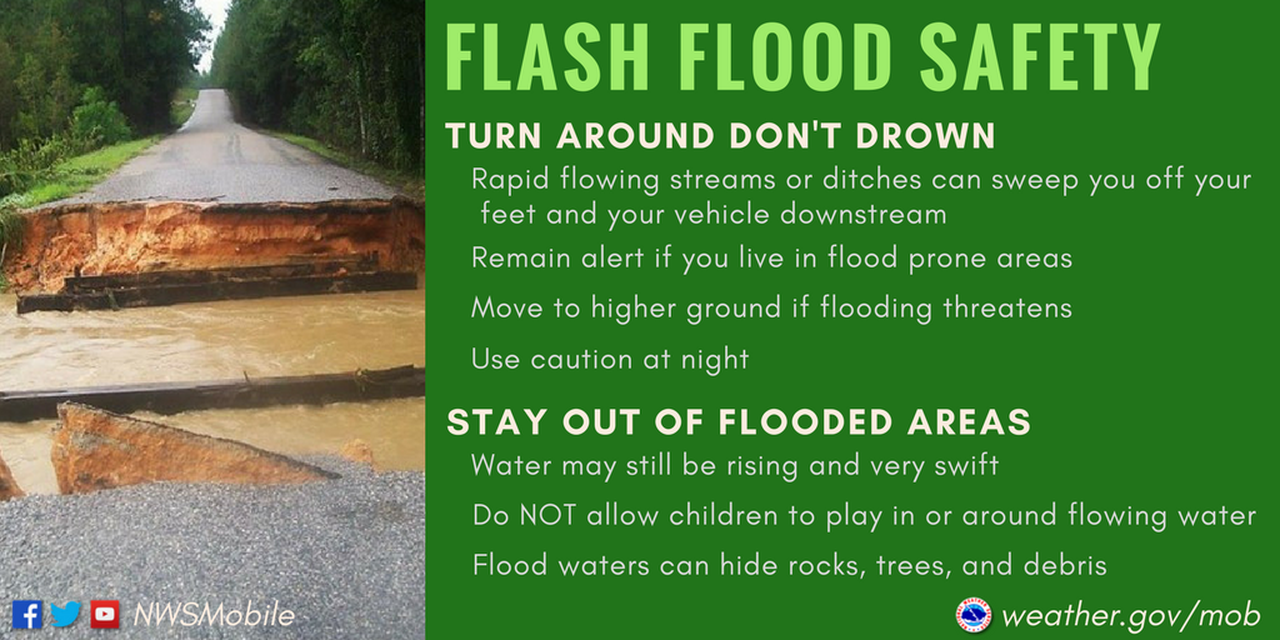How To Stay Safe During A Flash Flood Emergency

Table of Contents
<p><strong>Meta Description:</strong> Learn essential safety tips and preparedness strategies to protect yourself and your loved ones during a flash flood emergency. Discover how to react quickly and effectively when flash floods threaten your area.</p>
<p>Flash floods are sudden, dangerous events that can strike without warning, leaving little time to react. The ferocious power of rushing water can cause devastating damage and loss of life. Understanding how to stay safe during a flash flood emergency is crucial for protecting your life and property. This guide provides essential information and actionable steps to ensure your safety. We'll cover everything from preparedness before a flood warning to post-flood recovery procedures.</p>
<h2>Understanding Flash Flood Risks and Warnings</h2>
<h3>Identifying Flash Flood Prone Areas</h3>
<p>Knowing your risk is the first step to staying safe. Flash floods are more likely in certain geographic locations. Understanding these high-risk areas allows for better preparedness and faster response times during an emergency.</p>
<ul> <li><strong>Near rivers and streams:</strong> These waterways can quickly overflow their banks during heavy rainfall.</li> <li><strong>Canyons and gorges:</strong> Flash floods are particularly dangerous in these confined areas, where water can rise rapidly.</li> <li><strong>Deserts and arid regions:</strong> While infrequent, rainfall in these areas can lead to sudden and powerful flash floods.</li> <li><strong>Low-lying areas and floodplains:</strong> These areas are naturally prone to flooding due to their elevation.</li> <li><strong>Areas with poor drainage:</strong> Impervious surfaces, like concrete and asphalt, prevent water from soaking into the ground, increasing runoff and flood risk.</li> </ul>
<p>It's vital to check your local flood risk maps provided by your municipality or national weather service. These maps identify areas with a higher probability of experiencing flash flooding.</p>
<h3>Recognizing Flash Flood Warnings and Alerts</h3>
<p>Staying informed is paramount. Multiple warning systems are in place to alert you to impending flash floods. Familiarize yourself with these systems and know how to respond effectively.</p>
<ul> <li><strong>Sign up for emergency alerts:</strong> Most municipalities offer text or email alert systems. Register your contact information to receive timely warnings.</li> <li><strong>Understand weather reports:</strong> Pay close attention to weather forecasts, particularly during periods of heavy rainfall or thunderstorms.</li> <li><strong>Know the sounds of local warning sirens:</strong> Familiarize yourself with the sound of your community's emergency sirens and understand what actions to take when you hear them.</li> </ul>
<p>Remember, relying on multiple sources of information (weather apps, radio, local news) can ensure you receive comprehensive and reliable warnings.</p>
<h2>Preparedness Before a Flash Flood</h2>
<h3>Creating a Family Emergency Plan</h3>
<p>Preparation is key to surviving a flash flood. A well-defined family emergency plan will help you act quickly and efficiently when a warning is issued.</p>
<ul> <li><strong>Designate an out-of-state contact person:</strong> This person acts as a central point of contact for family members to check in during an emergency.</li> <li><strong>Pack an emergency kit:</strong> Include essential supplies (see next section).</li> <li><strong>Establish a communication plan:</strong> Designate a meeting place and pre-arranged methods for family members to communicate if separated.</li> <li><strong>Identify evacuation routes:</strong> Plan multiple escape routes from your home and know where to go if you need to evacuate.</li> </ul>
<p>It’s crucial to develop this plan before a flood warning is issued; time is of the essence during a flash flood.</p>
<h3>Building an Emergency Kit</h3>
<p>Your emergency kit should contain essential supplies to sustain you and your family for several days after a flash flood.</p>
<ul> <li><strong>Water:</strong> One gallon per person per day for at least three days.</li> <li><strong>Non-perishable food:</strong> Easy-to-prepare items with a long shelf life.</li> <li><strong>First-aid kit:</strong> Include essential medications and bandages.</li> <li><strong>Flashlight and extra batteries:</strong> For illumination during power outages.</li> <li><strong>Battery-powered radio:</strong> To stay informed about the emergency.</li> <li><strong>Important documents:</strong> Copies of insurance policies, identification, and other critical documents (stored in waterproof bags).</li> </ul>
<p>Regularly check the expiration dates of food and medications and replace them as needed to maintain the kit's effectiveness.</p>
<h2>Actions to Take During a Flash Flood</h2>
<h3>Evacuation Procedures</h3>
<p>If a flash flood warning is issued, evacuate immediately. Your life is more valuable than your property. Follow these steps to ensure your safety:</p>
<ul> <li><strong>Follow official instructions:</strong> Obey instructions from emergency officials and law enforcement.</li> <li><strong>Avoid flooded areas:</strong> Never attempt to walk, swim, or drive through floodwaters. The depth and current can be deceivingly dangerous.</li> <li><strong>Never drive through floodwaters:</strong> Even a small amount of water can sweep a vehicle away.</li> <li><strong>Move to higher ground:</strong> Seek refuge on higher ground away from flood-prone areas.</li> </ul>
<p>Remember, floodwaters can rise rapidly and unexpectedly. Your quick action can be the difference between safety and serious danger.</p>
<h3>Staying Safe Indoors During a Flash Flood</h3>
<p>If evacuation is not possible, take these steps to stay safe inside your home:</p>
<ul> <li><strong>Move to the highest level of your home:</strong> Seek refuge on the upper floors if possible.</li> <li><strong>Stay away from windows:</strong> Avoid areas that could be damaged by debris or floodwaters.</li> <li><strong>Turn off utilities if instructed:</strong> Follow instructions from officials regarding turning off gas, electricity, and water.</li> <li><strong>Monitor the situation:</strong> Keep listening to the radio or checking news for updates.</li> </ul>
<p>Staying informed and following instructions are key to surviving a flash flood while indoors.</p>
<h2>Post-Flash Flood Safety</h2>
<h3>Returning Home After a Flash Flood</h3>
<p>Returning home after a flash flood requires caution. The aftermath can be dangerous.</p>
<ul> <li><strong>Check for structural damage:</strong> Inspect your home for damage to the foundation, walls, and roof. Seek professional assistance if necessary.</li> <li><strong>Be aware of downed power lines:</strong> Avoid contact with any downed power lines; report them to authorities immediately.</li> <li><strong>Avoid contaminated water:</strong> Floodwaters can carry pollutants and disease-causing organisms. Avoid contact and clean up properly.</li> <li><strong>Report damage to authorities:</strong> Report any damage to your home or property to your insurance company and local authorities.</li> </ul>
<p>Take necessary safety precautions and do not rush the process. A thorough inspection is crucial.</p>
<h3>Cleaning Up After a Flash Flood</h3>
<p>Cleaning up after a flash flood requires careful attention to safety and proper disposal of hazardous materials.</p>
<ul> <li><strong>Wear protective gear:</strong> Use rubber boots, gloves, and a mask to protect yourself from contaminated water and debris.</li> <li><strong>Use appropriate cleaning solutions:</strong> Use disinfectants to clean up contaminated areas.</li> <li><strong>Dispose of debris and contaminated materials properly:</strong> Follow local guidelines for the disposal of hazardous materials.</li> </ul>
<p>For additional information on flood cleanup and assistance, contact your local emergency management agency or visit the website of your national weather service.</p>
<h2>Conclusion</h2>
<p>Staying safe during a flash flood emergency requires preparedness, awareness, and swift action. By understanding the risks, creating a plan, and following safety guidelines, you significantly reduce your vulnerability. Remember to prioritize your safety and the safety of your family. A proactive approach is far better than a reactive one when it comes to flash floods.</p>
<p><strong>Call to Action:</strong> Protect yourself and your family. Learn more about flash flood safety and develop your emergency plan today! Stay informed about flash flood warnings and be prepared to act quickly in a flash flood emergency. Don't wait for a disaster to strike; prepare for a flash flood now!</p>

Featured Posts
-
 Is A Canada Post Strike Pushing Customers Away
May 26, 2025
Is A Canada Post Strike Pushing Customers Away
May 26, 2025 -
 Catat Jadwal Moto Gp Inggris Rangkaian Balapan Dimulai Hari Ini
May 26, 2025
Catat Jadwal Moto Gp Inggris Rangkaian Balapan Dimulai Hari Ini
May 26, 2025 -
 Der Hsv Und Der Aufstieg Ein Blick Zwischen Hafengeburtstag Und Roland Kaiser
May 26, 2025
Der Hsv Und Der Aufstieg Ein Blick Zwischen Hafengeburtstag Und Roland Kaiser
May 26, 2025 -
 Glyantseva Zyomka Naomi Kempbell Bez Kompromisiv U Vidvertosti
May 26, 2025
Glyantseva Zyomka Naomi Kempbell Bez Kompromisiv U Vidvertosti
May 26, 2025 -
 Myrtle Beach Officer Involved Shooting Leaves 1 Dead 11 Injured Sled Investigation Details
May 26, 2025
Myrtle Beach Officer Involved Shooting Leaves 1 Dead 11 Injured Sled Investigation Details
May 26, 2025
